Rare pyramidal ice halos - Botswana
Rare Pyramidal Ice Halos - Botswana: A Unique Atmospheric Phenomenon
The skies above Botswana, Southern Africa, recently witnessed a truly extraordinary atmospheric spectacle - rare pyramidal ice halos. The captivating image captured by Shirley Shebadieta caught the attention of astronomer Stephen O'Meara, who then shared it with the world through OPOD/Atoptics Highlights. This peculiar display left experts puzzled due to its unusual characteristics.
Upon closer inspection, it became evident that this atmospheric phenomenon consisted of three equally spaced rings at the top and two at the bottom. Additionally, a brilliantly bright inner ring enveloped the overexposed sun. The distinct features of this halo display indicated the presence of pyramidal ice crystals suspended in high cirrus clouds. However, the precise nature of these halos remained enigmatic.
Typically, pyramidal crystal displays exhibit a distinctive pattern of rings that are not equally spaced. Normally, one would expect to observe a ring with a radius of 18 degrees, followed by a 20-degree halo, and a blur of 22, 23, and 24-degree halos. However, in this particular case, the rings were remarkably sharp and evenly spaced. This departure from the norm added to the intrigue surrounding these rare pyramidal ice halos.
To determine whether the observed arcs were genuine or mere camera artifacts, it is crucial to capture multiple handheld images. By comparing these images, any artifacts caused by the changing position of the sun become apparent, while real sky phenomena remain consistent. It is also essential to corroborate visual observations with what is visible to the unaided eye rather than solely relying on the camera screen. In the case of Shirley Shebadieta's photographs, both criteria were met, confirming the authenticity of the halo display.
The first outer ring presented a challenge in terms of identification. Its position suggested that it could not be the usual 18-degree halo, as the measurements based on the innermost ring being a 9-degree halo placed it further out. One possible explanation was a combination of 20, 22, and 24-degree circular halos. However, this hypothesis failed to account for the absence of the expected 18-degree halo, leaving experts unsettled.
After contemplating the mystery overnight, researchers turned to ray tracing simulations using HaloSim to shed light on the peculiar phenomenon. These simulations involved altering the shapes of pyramidal crystals, but this manipulation had little effect on removing the 18-degree halo while preserving the other rings. Frustration began to mount as a definitive explanation eluded them.
However, a breakthrough occurred when the idea of crystal orientation came to the forefront. Ordinarily, pyramidal crystal displays are rare due to their aerodynamic, rounded shapes, which deviate from the precise "plate" or "column" orientations of hexagonal prisms. Moreover, plate or column pyramidal displays do not produce the neat circular arcs observed in Shirley's Botswana photographs.
The key to understanding this phenomenon lay in considering crystal orientation rather than random orientations. By using HaloSim to simulate horizontally oriented pyramidal crystals, researchers were able to replicate Shirley's display accurately. The simulations produced three almost equally spaced arcs toward the zenith and two arcs at the bottom, with the innermost 9-degree halo arc shining brightly, mirroring the images captured by Shirley Shebadieta.
The solar altitude played a crucial role in the formation of these halos. With the November sun nearly overhead at a latitude of 20N in Botswana, the unique configuration of pyramidal crystals with wobbly horizontal column orientations perfectly matched the observed halo display. The resulting pattern consisted of three arcs approximately 20, 22, and 24 degrees from the sun in the zenith direction, accompanied by two arcs 22 and 24 degrees below. Notably, the continuous "22-degree" arc corresponded to the familiar circumscribed halo resulting from the central hexagonal prism section of the crystals.
Furthermore, the positioning of the sun significantly influenced the appearance of these halos. When the sun's altitude dropped below 75-80 degrees, the distinct pattern vanished. To confirm the accuracy of the solar altitude in relation to Shirley's photographs, Stephen O'Meara urgently requested verification of the time and date. The solar altitude was indeed recorded at 79 degrees, aligning perfectly with the desired conditions for the HaloSim ray tracing simulation.
In conclusion, the rare pyramidal ice halos observed in Botswana presented an exceptional and captivating atmospheric display. These halos, formed by horizontally oriented pyramidal ice crystals, defied conventional expectations and added an extra touch of rarity to an already extraordinary phenomenon. Through careful observation and advanced simulations, scientists were able to unravel the mysteries behind these unique atmospheric optics, shedding light on the intricate beauty of our atmosphere.
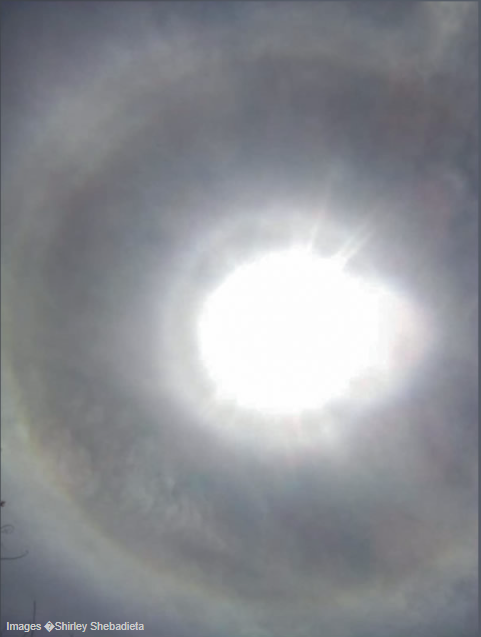
Very odd radius halos indeed
Shirley Shebadieta took the image at left in Botswana, Southern Africa.
Astronomer Stephen O�Meara forwarded it to OPOD/Atoptics Highlights.
There was something very strange going on. At top there are three equally
spaced rings while at bottom there are two. A very bright inner ring
surrounds the overexposed sun.
It looked like an odd radius halo display from pyramidal ice crystals in high
cirrus. The inner ring was possibly a 9 degree halo. But all the rings were
rather sharp, especially the inner one. More worrying, the outer rings of a
pyramidal crystal display are not equally spaced. There is usually a ring of 18
degree radius followed perhaps by a 20 degree halo and then a blur of 22,23
and 24 degree halos.

Usual appearance of odd radius halos. No equal spacing. Details here.
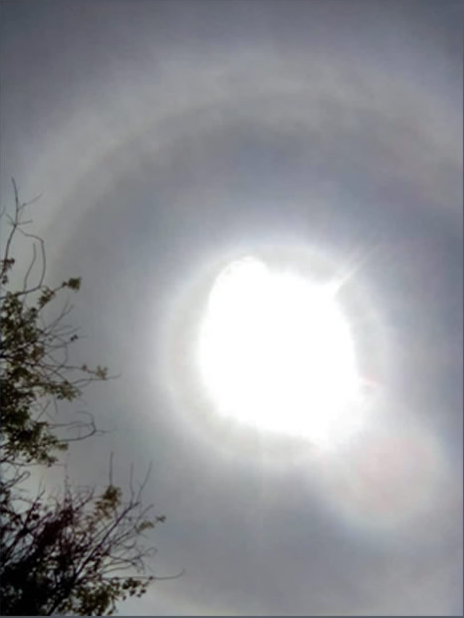
Were at least some of the arcs camera artefacts?
When something unusual is detected in the sky always take several hand-held images. The different positions of the sun in each frame cause artefacts to change position and be easily detected. A real sky object should be unchanged. Furthermore, check what is visible by the unaided eye - not just on the camera screen! Only if these conditions are met is the sighting just possibly real.
Shirley Shebadieta did see the arcs visually and took several images. Stephen O◆ Meara forwarded them. The camera was also checked against a clear sky and it did not produce artefacts. We had a real halo display but a very strange one.
The first outer ring was unlikely to be the usual 18 degree halo because measurements based on the innermost ring being a 9 degree halo put it further out. One possibility was a combination of 20, 22 and 24 degree circular halos. But I was uncomfortable with that as explaining the absence of an 18 degree halo was problematic.
I slept on it and next morning played with ray tracing simulations using HaloSim. Altering the pyramidal crystal shapes, as expected, did little to remove the 18 degree halo while keeping the others.

Some randomly oriented pyramidal crystals. All have the same interfacial angles but the length of the pyramidal and central prism sections can vary.
What if the crystals were oriented rather than had random orientations? Oriented pyramidal crystal displays are rare because the crystals are aerodynamically rather rounded and do not take up the precise �plate� or �column♦ orientations of ordinary hexagonal prisms. Anyway, plate or column pyramidal displays do not give neat circular arcs....but see below.
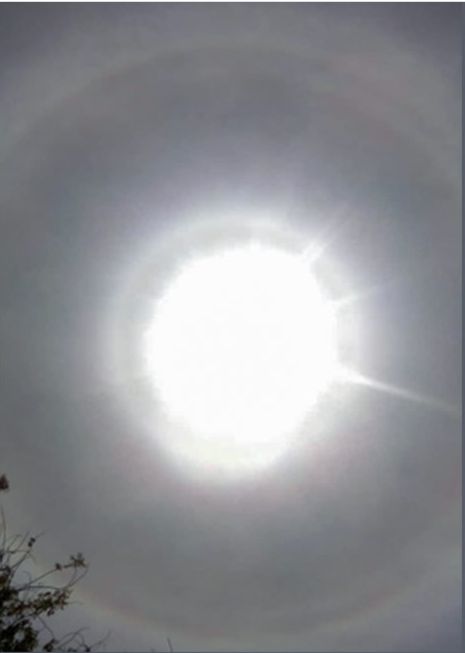
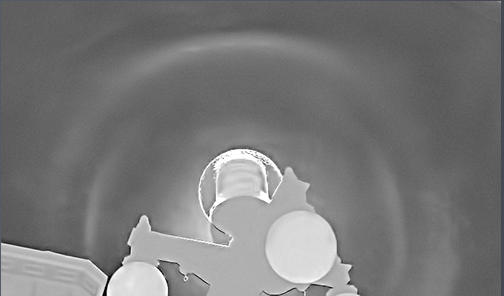
Halos from horizontal plate oriented pyramidal crystals seen by Alistair Fraser. Partial and typically diffuse. Not like Shirley's Botswana halos.
Then the penny dropped - It should have done so hours ago! Near noon the November sun is almost overhead at latitude 20N in Botswana.
Some �standard pyramidal crystals with equal length truncated pyramids and central prism were put into HaloSim. I gave them very wobbly horizontal column orientations.
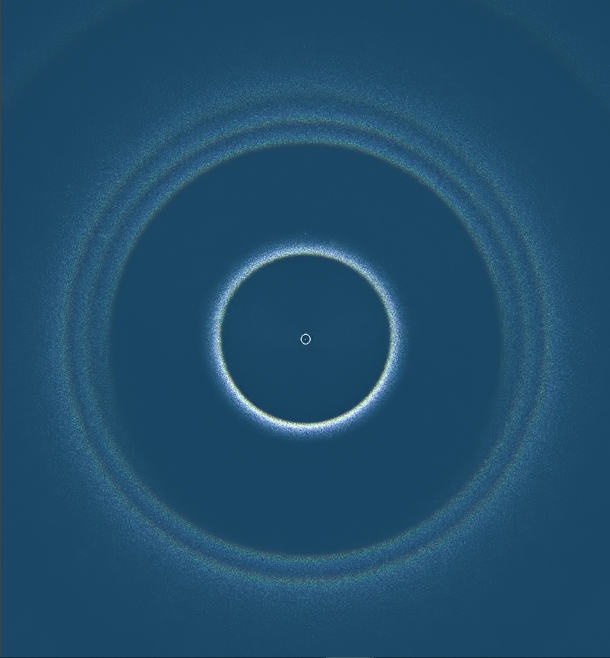
A ray tracing for a 79 degree high sun and pyramidal crystals with wobbly horizontal column orientations neatly reproduces Shirley's display. Three almost equally spaced arcs towards the zenith and two at bottom. The 9 degree halo arc is very bright as in the images.
Then the penny dropped - It should have done so hours ago! Near noon the November sun is almost overhead at latitude 20N in Botswana.
Some �standard◆ pyramidal crystals with equal length truncated pyramids and central prism were put into HaloSim. I gave them very wobbly horizontal column orientations.
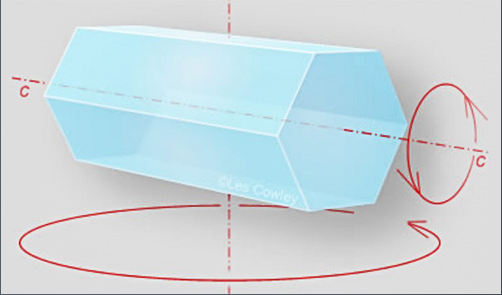
Horizontal column orientation. The crystal's long axis is horizontal. the crystal takes all rotational positions around it. This one is an ordinary ice prism. Imagine pyramidal ends to make the crystals talked of here.
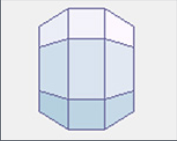
The crystal used for ray tracing. Ones with a longer hexagonal prism centre section are more likely to be horizontally oriented. However, playing with the multiple parameters of crystal habit in ray tracings can be overdone.
The solar altitude was set to 80 degrees and the ray tracing started. The machine ran millions of rays through the crystals and on the screen Shirley◆s display popped straight out! There were three arcs roughly 20,22 and 24 degrees from the sun in the zenith direction with only two arcs 22 and 24 degrees below. The continuous '22 degree' arc is of course the familiar circumscribed halo from the central hexagonal prism section of the crystals.
The arcs were quite sun altitude sensitive - drop the sun below 75-80 degrees and the pattern goes. I anxiously mailed Stephen O�Meara to have Shirley check the time and date and thus the solar altitude. Yes! It was 79 degrees, just as wanted. The HaloSim ray tracing is at left.
A very unusual halo display indeed - and well observed. Horizontally aligned pyramidal ice crystals created it. If the sun had been a little lower the halo arcs would still have been rare but of more conventional appearance. The very high sun added that touch of extra rarity and challenge.
Note: this article has been automatically converted from the old site and may not appear as intended. You can find the original article here.
Reference Atmospheric Optics
If you use any of the definitions, information, or data presented on Atmospheric Optics, please copy the link or reference below to properly credit us as the reference source. Thank you!
-
<a href="https://atoptics.co.uk/blog/rare-pyramidal-ice-halos-botswana/">Rare pyramidal ice halos - Botswana </a>
-
"Rare pyramidal ice halos - Botswana ". Atmospheric Optics. Accessed on November 26, 2024. https://atoptics.co.uk/blog/rare-pyramidal-ice-halos-botswana/.
-
"Rare pyramidal ice halos - Botswana ". Atmospheric Optics, https://atoptics.co.uk/blog/rare-pyramidal-ice-halos-botswana/. Accessed 26 November, 2024
-
Rare pyramidal ice halos - Botswana . Atmospheric Optics. Retrieved from https://atoptics.co.uk/blog/rare-pyramidal-ice-halos-botswana/.